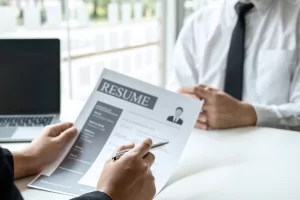Applying for a job is a big step, but sometimes, plans change. Maybe you found another opportunity, realized the role isn’t the right fit, or decided to take a break from job hunting. Whatever the reason, knowing how to withdraw an application the right way is important. It helps you stay professional, keeps a good relationship with hiring managers, and leaves the door open for future opportunities.
Want to make sure you handle it smoothly? Let’s go over the best way to withdraw a job application professionally.
Common Reasons to Withdraw a Job Application
There are many valid reasons why you might need to withdraw an application before the hiring process is complete. If you’re having second thoughts, you’re not alone! Here are some of the most common reasons job seekers decide to step back:
1. You’re No Longer Interested in the Position
Maybe the job sounded great at first, but after learning more about it, you realized it’s not the right fit. If you’ve lost interest in the position, it’s best to withdraw a job application early instead of continuing through the process when you know you won’t accept the offer.
2. You’ve Accepted Another Job Offer
Landing a job can happen faster than expected! If you’ve already accepted another job, there’s no need to keep interviewing for a role you won’t take. Letting the employer know as soon as possible helps them move forward with other candidates.
3. The Salary or Benefits Don’t Meet Your Needs
A job should align with your financial and professional goals. If the job offer doesn’t include a salary, benefits, or work-life balance that meets your needs, it’s okay to withdraw an application instead of spending time negotiating something that won’t work for you.
4. Your Personal Circumstances Have Changed
Life happens, and sometimes plans change. Whether you’re relocating, dealing with a family emergency, or putting your job search on hold, withdrawing your application is the professional way to step back from the hiring process without sacrificing future interactions.
5. The Interview Process Raised Red Flags
Did something feel off during the interviewing process? Maybe the company seemed disorganized, the role’s expectations weren’t clear, or online reviews raised concerns. If you have doubts, it’s completely okay to withdraw a job application instead of moving forward with a company that doesn’t feel right.

How to Professionally Withdraw Your Job Application
When you withdraw an application, the goal is to do it professionally and respectfully. Whether you’ve accepted another job or decided the role isn’t the right fit, handling it the right way helps maintain good relationships with employers. Here’s how to do it properly:
1. Withdraw as soon as possible.
Once you’re sure about your decision, don’t wait. The sooner you let the employer know, the more time they have to focus on other candidates in the hiring process. Delaying could inconvenience them and leave a negative impression.
2. Use a polite and professional tone.
Even if you’re no longer interested in the position, professionalism matters. Thank the employer for their time and consideration and express appreciation for the opportunity. Maintaining a respectful tone can leave a positive impression for future opportunities.
3. Keep it brief and clear.
There’s no need for a long explanation. A simple, direct withdrawal email or letter that thanks the employer and informs them of your decision is enough. Avoid over-explaining or providing unnecessary details.
4. Address the right person.
Send your withdrawal letter or email message to the right contact, whether it’s a recruiter or the hiring manager. This ensures clear communication and avoids any confusion in the application process.
5. Offer to stay in touch.
If you liked the company but not the specific role, mention your interest in future opportunities. Building relationships during your job searches can lead to great connections down the road.
6. Be honest but tactful.
If you’re withdrawing due to a job offer, a mismatch in expectations, or concerns raised during the interviewing process, be honest—but professional. You don’t have to go into detail, but a simple statement like, “I’ve decided to pursue a different opportunity,” keeps things transparent without burning bridges.

Essential Tips for Writing a Job Application Withdrawal Letter
A well-written withdrawal letter maintains professionalism and leaves a positive impression. Here’s what to include:
1. Use a clear and direct subject line.
Your subject line should immediately convey the purpose of your message. A straightforward subject like “Withdrawal of Job Application – [Your Name]” ensures your email is recognized and understood right away.
2. State your intent clearly.
Start your letter with a clear statement of your intent to withdraw your application. Example: “I am writing to formally withdraw my application for the [Job Title] position at [Company Name].” This direct approach eliminates any ambiguity.
3. Keep your reason brief (optional).
Providing a reason for withdrawing your application is not necessary, but if you choose to include one, keep it concise and professional. A simple explanation such as “I have decided to pursue another opportunity that aligns better with my current career goals” is sufficient. Avoid negative remarks about the company or the role.
4. Express gratitude.
Showing appreciation for the employer’s time and effort in reviewing your application is a professional gesture. You can say something like, “I sincerely appreciate the opportunity to apply for this role and the time your team has spent considering my application.”
5. End on a positive note.
Conclude your letter with a polite and professional closing. If you’re open to future opportunities with the company, you can mention it: “I hope to stay in touch and would love to explore potential opportunities with [Company Name] in the future.” End with a courteous sign-off like “Best regards” or “Sincerely,” followed by your name.

Job Application Withdrawal Letter Examples
Below are five examples of job application withdrawal letters for different situations.
Example 1: Simple and Direct
Subject: Withdrawal of Job Application – [Your Name]
Dear [Hiring Manager’s Name],
I hope you’re doing well. I am writing to formally withdraw my application for the [Job Title] position at [Company Name]. After careful consideration, I have decided to move forward with another opportunity.
I truly appreciate the time and effort you and your team have put into my application. Thank you for your consideration, and I wish you success in finding the right candidate for the role.
Best regards,
[Your Name]
Example 2: Appreciative and Respectful
Subject: Withdrawal of Job Application – [Your Name]
Dear [Hiring Manager’s Name],
I want to express my gratitude for the opportunity to apply for the [Job Title] position at [Company Name]. However, I would like to formally withdraw my application as I have decided to take another direction in my job search.
I sincerely appreciate the time, effort, and consideration given to my application. It was a pleasure learning about [Company Name], and I hope our paths cross again in the future.
Wishing you and your team all the best.
Sincerely,
[Your Name]
Example 3: Keeping Opportunities Open
Subject: Withdrawal of Application – [Your Name]
Dear [Hiring Manager’s Name],
I wanted to inform you that I am withdrawing my application for the [Job Title] position at [Company Name]. While I appreciate the opportunity, I have decided to take a different career path at this time.
That being said, I remain very interested in [Company Name] and would love to stay connected for potential future opportunities. Thank you again for your time and consideration. I look forward to staying in touch.
Best regards,
[Your Name]
Example 4: Withdrawal Due to Personal Reasons
Subject: Withdrawal of Job Application – [Your Name]
Dear [Hiring Manager’s Name],
I hope this message finds you well. Unfortunately, due to unforeseen personal circumstances, I must withdraw my application for the [Job Title] position at [Company Name]. This was a difficult decision, as I was excited about the opportunity to join your team.
I greatly appreciate the time and effort you have taken to review my application, and I hope to have the opportunity to apply again in the future when the timing is right. Thank you for your understanding.
Best regards,
[Your Name]
Example 5: Withdrawal After Receiving Another Offer
Subject: Withdrawal of Job Application – [Your Name]
Dear [Hiring Manager’s Name],
I wanted to reach out to inform you that I am withdrawing my application for the [Job Title] position at [Company Name]. I have recently accepted another offer that aligns with my current career goals.
I truly appreciate the opportunity and the chance to learn more about [Company Name]. It was a pleasure speaking with you, and I hope to stay in touch for potential opportunities in the future.
Wishing you all the best in your hiring process.
Sincerely,
[Your Name]
Professional Email Templates for Withdrawing a Job Application
Along with formal letters, you can also send emails to withdraw your job application. Whether you’re stepping back before an interview or after, it’s important to communicate your decision professionally and courteously. Here are some examples to guide you.
Email Template for Withdrawing Before an Interview
Subject: Withdrawal of Job Application – [Your Name]
Dear [Hiring Manager’s Name],
I appreciate the opportunity to be considered for the [Job Title] position at [Company Name]. After some careful thought, I’ve decided to withdraw my application at this time.
Thank you for your time and consideration. I truly appreciate the opportunity, and I wish you success in finding the right candidate for the role.
Best regards,
[Your Name]
Email Template for Withdrawing After an Interview
Subject: Withdrawal of Application – [Your Name]
Dear [Hiring Manager’s Name],
Thank you for the opportunity to interview for the [Job Title] position at [Company Name]. It was a pleasure learning more about the role and your team. However, after giving it some thought, I’ve decided to withdraw my application.
I’m grateful for the time and effort you and your team have put into the process. I truly appreciate the experience and hope our paths cross again in the future.
Wishing you all the best,
[Your Name]
Stand Out with a Professionally Written Resume
Withdrawing an application doesn’t mean the end of your job search—it’s just a step toward finding the right opportunity. Knowing how to professionally withdraw from a job application helps you maintain positive relationships and stay open to potential roles in the future.
Now, it’s time to focus on landing your ideal job. A standout resume is your key to getting noticed by top employers, and at Resume Professional Writers, we specialize in crafting resumes that showcase your skills, experience, and accomplishments. Whether you’re making a career change or want to elevate your job search, our expert writers are here to help. Let’s create a resume that gets you hired!








